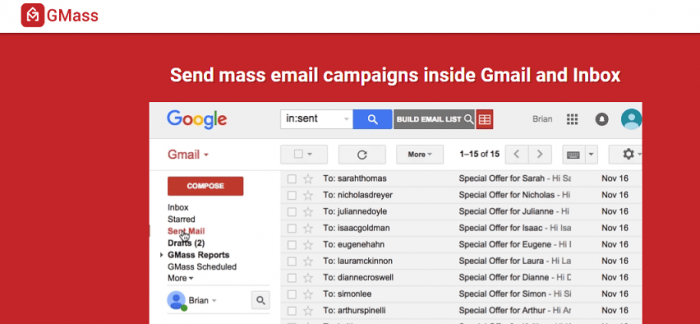From Creating Professional-Level Imagery to Saving Time with a Mail Merge Extension, Here’s How to Step-Up Your Email Game
Getting your home business off the ground isn’t easy. It requires research, strategy, and a whole lot of patience. Luckily, thanks to modern technology, there are plenty of online tools that you can use to expand your customer base (using a platform that you already have, like Gmail) and heighten your earnings.
In today’s world of social media, you might think that launching an email marketing campaign isn’t the most efficient way to grow your business. However, that’s a common misconception. While social media is certainly an excellent method by which you can generate brand awareness and increase your website’s traffic, that doesn’t mean that you should write off emails (pun intended!).
Not only does email have a larger user base than social media, but it also surpasses social media in terms of return on investment. So when it comes to growing your business, you want to use both social media and email marketing.
Starting Your Email Marketing Campaign
Though it has the potential to be highly beneficial, starting an email marketing campaign isn’t easy or quick. The good news is it’s cheap, trackable, and it ensures that your content is being delivered directly to your intended viewers (but whether they open it or not is another matter entirely). Don’t know where to begin? Try establishing some basic goals first, such as:
- What do you want to achieve with this campaign?
- Who do you want to target?
- What kind of emails would your audience members interested in?

Without the right amount of focus, any type of marketing strategy is bound to fail. That’s why it’s important to know what you want from your email campaign so that you can determine the best way to approach it.
Types of Email Marketing
There are different types of email marketing, each designed to serve a specific purpose. The kind of emails that you send are usually based on your business and what it does.
Engagement
Engagement emails are more about (you guessed it) creating engagement with your brand than about making actual sales. This means that you want your copy to be exciting and memorable, both visually and content-wise. While you will most likely employ a varied approach to your email campaign, these are some standard forms of engagement that you might want to try out:
- Welcome emails — A welcome email does just that, welcomes a new subscriber or customer to your brand and familiarizes them with your content or services.
Welcome emails are simple but effective. It’s pretty much the virtual version of a greeter standing outside of a store. Image courtesy of Grow Revenue.
- Tutorials and tips — Emails that explain how to use a product or provide tips for getting the best results from a product or service are a great way to interact with a customer and build their relationship with your brand.
- Brand stories — Sharing more about yourself and other members of your team humanizes your brand and appeals to customers on a personal level. While this is the perfect time to show off some storytelling skills, you don’t want to write an autobiography. Be sure to keep your anecdotes short enough that you don’t lose your reader’s attention.
Transactional
Transactional emails are more direct, the focus being to land or close a sale. These emails are usually triggered automatically in response to customer actions. Examples of transactional emails include:
- Abandoned cart reminders — Follow up with customers who added a product to their online cart but never completed the purchase with an abandoned cart reminder. Make it easy for a customer to pick right back up with their shopping by including a call-to-action button that will take them straight to your website.
- Time-sensitive promotions — If your website is having some kind of limited-time offer, you want to make sure that your customers know about it. Email them at the beginning of the sale to get them thinking about your products and at the end of the sale to remind them that the deal will be ending soon.
- Review requests — Build your company’s credibility with reviews from real customers. These emails also give you a chance to continue engaging with an already established buyer, which can help solidify their relationship with your brand.
Email Marketing Tools
Online tools make all the difference in email marketing. From building your emails to tracking your tactics, you can find a marketing tool to perfect just about every aspect of your campaign. Not a tech wiz? Don’t worry, most of them are pretty easy to use—you just have to find the right ones for your business.
Design and Templates
Visual appeal is a huge factor in email marketing. You want to catch the reader’s eye with colorful images, embedded videos, infographics, and more. But you don’t need a background in design to make your emails stand out, just a good building tool.
Mail Merge
A mail merge lets you send personalized emails on a mass level, allowing you utilize an individualized approach to your email campaign in a way that’s still feasible. Even if you use an email provider that isn’t conducive to mass sending, you can download a mail merge extension so that you can stay with the provider that you’ve always used (Gmail, Yahoo, Outlook, etc.).
If you’re a Gmail user who’s trying to start an email marketing campaign, using a mail merge tool like GMass can make your life a lot easier. Image courtesy of What’s New On the Net.
Analytics
How are you supposed to know what’s working and what’s not if you have no way to analyze the data? You can use an analytics tool to review metrics like click rates, bounce rates, unsubscribe rates, conversation rates—and pretty much any other rate that you need. You can also run your email list through an email verification service to remove invalid emails and increase the deliverability rate. This way you can adapt your marketing strategy as you go along and optimize your email campaign to its fullest extent.
Before You Press Send
After you establish all of the logistics behind your email marketing campaign, it’s time to get to the fun part—drafting your emails! But before you press send, don’t forget that the little things matter. While the body of the email certainly isn’t something to overlook, you still want to put a lot of thought into the smaller, more subtle aspects, like the subject line and your email signature. Details are everything, so make sure to get the most out of every element of the email. Annnnnd send!
Find a Home-Based Business to Start-Up >>> Hundreds of Business Listings.
















































